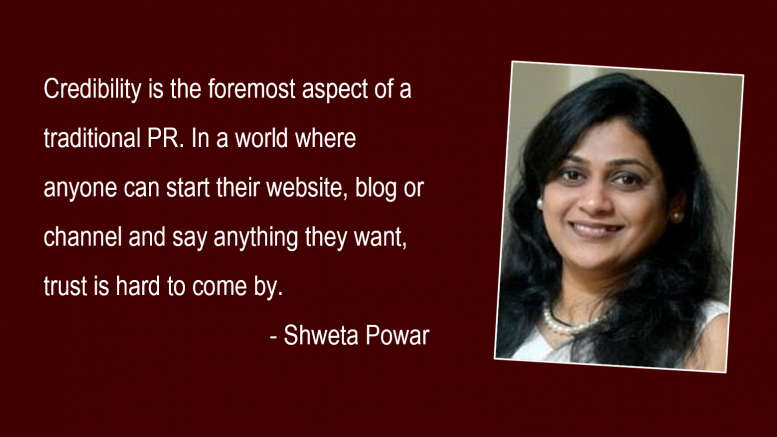Earlier when the internet was still a new phenomenon, it could trigger strong emotions. Every experience associated with it felt very novel and afresh. But slowly, the internet became an integral part of our lives, a daily routine. That means the feelings and emotions it transmits has now become limited. This is where print propagation, which has fought its way back to become more creative, unique and important than ever comes into the picture.
The ongoing evolution of digital marketing has drastically changed public relations over the past decade. Today, PRs have embraced digital strategies to reach a much broader audience and organise successful campaigns. However, it remains relatively obscure that success of digital PR in tandem with print is the most powerful branding technique that brands are missing on.
Digital PR unlocks hidden value
Digital PR empowers brands to unlock their potential across mediums and regions by reaching new consumers. The understanding of search engines and the ability to work efficiently alongside SEO specialists, social media experts and content marketers have led digital PR to create new marketing opportunities.
Digital PR is also instrumental in effectively tracking, monitoring, and measuring campaigns to enable clear reporting of the outcomes of the PR strategies and demonstrate the exact value campaigns have added. From boosting rankings on search engine pages to publishing story-focused content which people want to share, from influencer-led strategies to using social media tools to spark conversations on multiple digital platforms, digital PR, effective in reach and engagement, provides a competitive edge and leads to better targeting and metrics.
The risk of a digital-only approach
Many brands are heavily focused on a risky digital-only approach to captivate their audience. This comes at the expense of companies’ relationships with consumers who are increasingly growing disconnected and dissatisfied. With the rapid proliferation of digital technology across the spectrum, signs are emerging that consumers are approaching a saturation point and experiencing digital fatigue. Therefore, amidst the digital clutter, brands need to find ways to cut through the digital noise to realise their true revenue generation potential.
The Importance of traditional PR
Physical presence: A physical object provides a sense of realness. It is something that the brain remembers much more vividly. A recent study has found that physical things are more real to the brain as it engages with the spatial memory networks. This means that people can associate more with a brand if they’re engaging with something physical. Therefore, this unique power of traditional PR alongside digital PR strategy is the right mix for brands to not only engage leads on two fronts but also build a trustworthy brand identity.
Longevity: Unlike online media which has a low shelf-life, print sticks around for years, at least, if it is cared for. A thought-provoking print article can happily sit somewhere in an office or house to be picked up and read again. In addition to this, as people are often distracted on the internet, print contents have a bigger impact on mindshare for a brand.
Credibility: Credibility is the foremost aspect of a traditional PR. In a world where anyone can start their website, blog or channel and say anything they want, trust is hard to come by. The stringent requirements of print publications ensure trustworthy contents find its way to readers.
Less competition: The internet is a highly saturated market with thousands of articles, blogs and ads being posted and updated daily which can be overwhelming for average consumers. Further, the ease of use and powerful targeting tools of digital advertising lead to companies competing for the top spots which usually the ones with more money gets. Therefore, amid the oversaturation of digital branding, campaigns, and advertising space, print is a great way of getting away from that volatile marketplace.
Integration of digital and traditional PR
The integration of digital and traditional PR is inevitable. Carefully designed, well-executed and coordinated PR strategies allow print marketing and digital initiatives to seamlessly work together and deliver a powerful impact. Be it creating a consolidated team to ensure all the marketing collateral, mediums, and channels are interlinked and support each other, understanding the right balance based on campaigns’ goals and being strategic about what is offered and to whom or simply knowing the target audience, a holistic PR framework will ensure to put an effective integrated strategy which will build, create, and establish brand awareness and support growth.
The bottom line:
Despite the rising prevalence of digital PR, traditional PR regardless of its conventional nature will always remain relevant. To overlook the vital integrated and holistic approach of combining the two means that companies are missing opportunities to boost their campaign ROI and connect with consumers in a trusted and meaningful way. Staying relevant in this highly competitive business environment requires new strategies and practices in which digital and print work in sync to deliver superior results.
The views and opinions published here belong to the author and do not necessarily reflect the views and opinions of the publisher.



Be the first to comment on "Print or digital PR : What works best for brands"